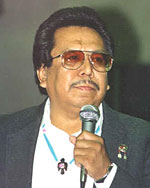By Tom Robertson
Minnesota Public Radio
June 5, 2002
Census figures released this week show people living on Indian reservations did better in the 1990s than the previous decade. During the casino era of the 1990s, incomes climbed and poverty fell on most reservations. A few saw tremendous income growth that outpaced the state average. But reservations have had a lot of catching up to do, and most are still struggling with poverty, housing shortages and unemployment.
| |
|
|
|
||
The latest census figures offer strong support for the notion that the gaming industry has had a major impact on the economies of Indian reservations in Minnesota. The federal government's census 10 years ago was done before Minnesota tribes built their casinos. Since then, the median income on the state's 12 reservations rose, on average, 141 percent.
The average income on the Mille Lacs reservation, for example, is now about $30,400. That's nearly $17,000 less than the state average. But Mille Lacs planner Don Wedll says it's a far cry from the old days.
"Poverty was rampant in the '50s, '60s, '70s and '80s. And you know, that's finally starting to turn around. I don't think you can expect that in a 10-year cycle that's all going to be fixed magically," says Wedll.
Mille Lacs ranked as one of the poorest reservations in the country in 1990. It had a poverty rate of nearly 81 percent. The latest census shows the rate has fallen to about 17 percent. The number of owner-occupied homes jumped nearly 1,000 percent, from 81 to 887.
But the reservation still has its problems. The new figures show a 160 percent increase in the number of people living below the poverty level. Don Wedll says that's because people who have moved away are returning to the reservation looking for work.
| |
|
|
|
||
"There's still people who are unemployed...there's still people who are in the poverty level. It hasn't fixed everything. But I do think it shows that given the economic tools, that reservations can change the poverty cycle that they were in," Wedll says.
Officials from the state demographer's office say this latest round of census data doesn't tell the whole story of what's happening to Indians in Minnesota. The data on reservations is not race-specific. It doesn't, for example distinguish between Indians and non-Indians who live on reservations. State demographer Tom Gillaspy says it also doesn't say anything about the many Indians who don't live on reservations.
"From this we can't say anything about what has happened to the economic situation of the American Indian population. We're going to have to wait for more information," says Gillaspy.
While reservations closer to the Twin Cities metropolitan area show dramatic jumps in income, employment and other indicators, the largest reservations, located in northern Minnesota, are showing more modest gains. The Red Lake reservation had double-digit increases in household income and the number of owner-occupied homes.
|
"I see a lot of people yet that still have poor housing, cars that barely run, and no jobs. So even though...these numbers look good, I think the reality is there still are a large number that are still very poor."
- Shirley Cain, The American Indian Resource Center |
Chairman Bobby Whitefeather credits gaming as a major factor. He also points to another phenomenon over the past decade. He says Red Lake and other tribes are succeeding because they've rejected control by the Bureau of Indian Affairs. Whitefeather says the trend is toward self-governance and economic self-determination.
"It's just truly remarkable, I believe, that the tribe is able to do this, once we shook the shackles of the federal government off our hands and our legs. And we're doing things on our own. And it demonstrates that that's what should be going on, that's what should be happening," says Whitefeather.
While the latest round of census data tells a positive story, Shirley Cain of the American Indian Resource Center at Bemidji State University says many reservations still have a long way to go.
"I see a lot of people yet that still have poor housing, cars that barely run, and no jobs. So even though, yes, these numbers look good, I think the reality is there still are a large number that are still very poor," Cain says.
Census figures show the apparent affects of Indian-run casinos go beyond reservation boundaries. Many Minnesota counties with the largest growth in income the past decade either have a casino, or border on a county that has one.
The next round of census data won't be released until at least this fall. That information is expected to paint a more complete picture of how the state's Indian community is doing.
More from MPR

